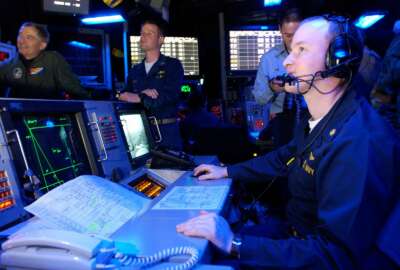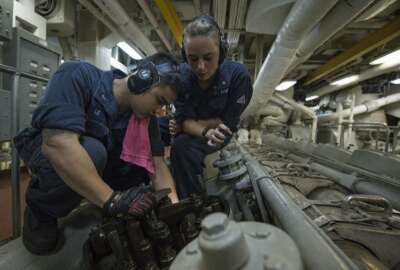

The Navy, Marines and Coast Guard are looking for new ways to apply technology to their training curricula, but only where it makes sense to do so.
The military’s sea services say they are on the cusp of a revolution in how they train their personnel.
The Navy, Marine Corps and Coast Guard are each approaching the problem from slightly different angles, but they agree on at least a few things: The standard model of point-in-time, and schoolhouse-based training is not always the best approach. Different people learn at different paces, and modern technology offers extremely promising ways to make military training more effective.
Computer-based training is certainly not a new concept, and the Navy has no interest in repeating some of the past mistakes it’s made in attempting to replace vital hands-on qualifications with CBT, said Rear Adm. John Nowell, the service’s director of military personnel plans and policy.
But technology can certainly help in tailoring some of its training on an individual basis, and delivering it exactly when it’s needed.
“The way we’ve been doing businesses, we give folks a lot of training before they go to their first ship, but they only use about half of that,” he said during a panel discussion at the annual Sea Air Space conference. “About half of them stay in, and we have to give them the training all over again because the skills have atrophied, the technology has changed, or they didn’t use it in their first tour. It makes no sense.”
So the Navy has moved to a concept it calls “block learning” under the banner of a broader initiative called “Ready, Relevant Learning.” It borrows from a continuous learning model already used in the service’s nuclear and special operations communities, and the Navy had adopted the practice for 54 of its ratings by the end of last year, Nowell said.
“The idea was to figure out where in their career sailors needed the training, and therefore we cut some of the initial entry training down, and in some cases, we added it,” he said. “Now we’re into how we might deliver it differently – content modernization. We know that they learn better by not having Ferris Bueller’s professor go through PowerPoint slides. So can they do it better on a device? Do they do it better with an avatar, for instance, like we do with our LCS engine room trainer in San Diego? We’re already doing some of this virtually.”
The content modernization effort is likely to mean servicemembers will have more opportunities to conduct training on schedules that suit their personal lives, and in many cases, on their own devices. The Navy is in the midst of a major IT modernization effort that is moving many of its training resources from behind Common Access Card-protected firewalls and exposing personnel and training systems to sailors’ personal devices.
The Marines are pursuing a similar line of thinking, said Brig. Gen. Calvert Worth, the commander of Marine Corps Training Command. He said the service aims to create a “persistent learning environment” that does not begin and end at the doors of a traditional schoolhouse.
“We need to flip the classroom so that the student becomes the center of that universe,” he said. “It needs to be dynamic, enabled by technology, allow a student to learn at a pace that they can learn at. You can aboard any college campus and the students can access the Internet from wherever they are on campus: if they want to learn, they can learn. If they want to move more rapidly through the information and the technical curricula, than they can do that at their pace. We should encourage that. That requires a shift, a revolutionary shift in how we’ve delivered training and education.”
At the same time, the services say they’re trying to take a measured approach so that they don’t attempt to replace training that truly does require hands-on experience with computer-based models. Worth said the Marine Corps has conducted several studies over the past two years to help determine where technology can help and where it can’t.


Rear Adm. Brian Penoyer, the commander of Coast Guard Force Readiness Command, said his service began moving toward a similar, more distributed and performance-based training model many years ago. The moves were motivated partly by constraints associated with the Coast Guard’s relatively small size and budget.
But however beneficial it might be to diversify military training with more tailored, non-classroom-based methodologies, he cautioned the approach is unlikely to be a major source of financial savings for the military services.
“It doesn’t save you instructional staff. In fact, there’s countless study after study that shows you need more staff, but different staff. That’s one of the reasons this is a revolution,” he said. “And the revolution presents several challenges to us. One is this question of what is that instructional workforce being trained to do? Who are you picking? As we move to this tailored training that knows who you are and is responsive to what operators are seeing in the field, it’s going to require us to completely revisit the industrial processing plant that we call training. You might drop into modular weeks while the course is in mid-progress, and we may have revolving graduation on a weekly or daily basis. Everything about that is exponentially hard to execute at a training center, and it’s not going to get easier unless we start from the principle that we’re going to operate our training with agile methodologies.”
Copyright © 2025 Federal News Network. All rights reserved. This website is not intended for users located within the European Economic Area.
Jared Serbu is deputy editor of Federal News Network and reports on the Defense Department’s contracting, legislative, workforce and IT issues.
Follow @jserbuWFED
